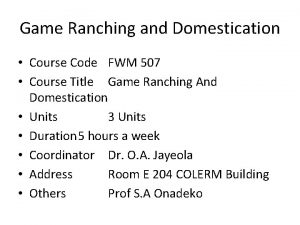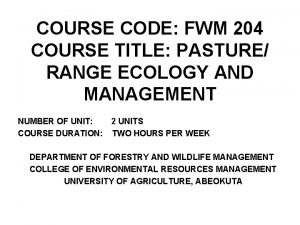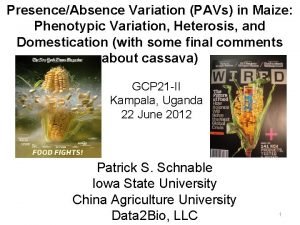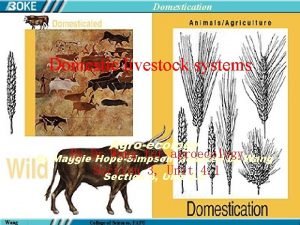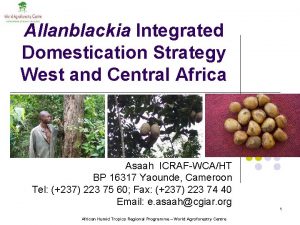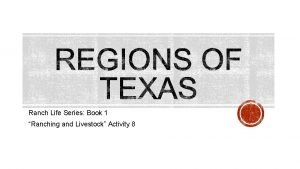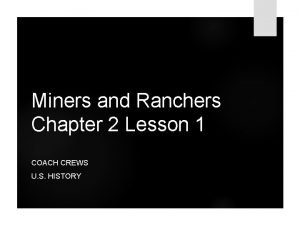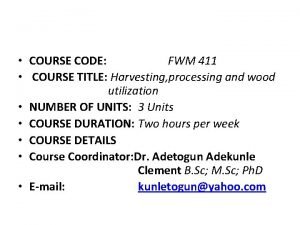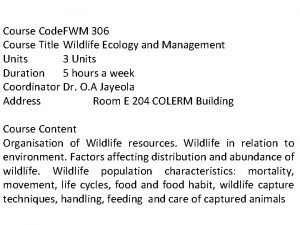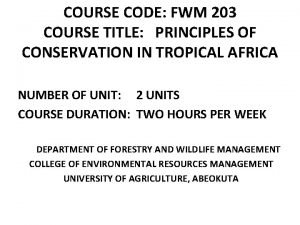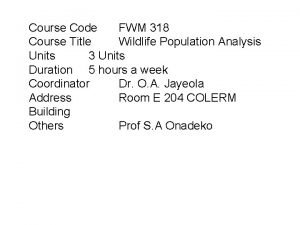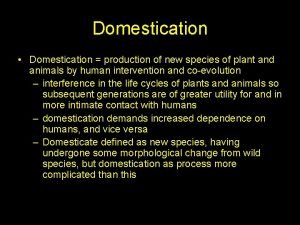Game Ranching and Domestication Course Code FWM 507









- Slides: 9

Game Ranching and Domestication • Course Code FWM 507 • Course Title Game Ranching And Domestication • Units 3 Units • Duration 5 hours a week • Coordinator Dr. O. A. Jayeola • Address Room E 204 COLERM Building • Others Prof S. A Onadeko

Game Ranching and Domestication • • History of Ranching and Domestication Types and Level of Domestication Basis for selection of species Experimental approach to Ranching and Domestication Planning and Design of Cages for various game species Growth behavior of Reproduction of Game species Food Preference Health care and Game husbandry technique.

History of Domestication • Domestication (from Latin domesticus) or taming is the process whereby a population of animals or plants, through a process of selection, becomes accustomed to human provision and control. A defining characteristic of domestication is artificial selection by humans. Some species such as the Asian Elephant, numerous members of which have for many centuries been used as working animals, are not domesticated because they have not normally been bred under human control, even though they have been commonly tamed. Humans have brought these populations under their care for a wide range of reasons: to produce food or valuable commodities (such as wool, cotton, or silk), for help with various types of work (such as transportation or protection), for protection of themselves and livestock, to enjoy as companions or ornamental plant, and for scientific research, such as finding cures for certain diseases. . . . .

Attributes of Animal to be Domesticated Flexible diet. Reasonably fast growth rate. Ability to be bred in captivity. Pleasant disposition. Temperament which makes it unlikely to panic. • Modifiable social hierarchy. • • •

REASONS FOR GAME DOMESTICATION • • • Food e. g. meat, milk Pet Biomedical research Source of income Protection Hunting Scientific research Bye – product like hide and skin, borns and tusks Employment Posterity Source of animal power To prevent extinction

PRELIMINARY STUDIES FOR DOMESTICATION • • • • Acceptability for consumption. Certain aspects of its biology should be studied. Parasitic infection – Intestinal, blood skin. Habitat – Construction of cages should be based on the behavioural pattern of the animals, ventilation, space, . Habitat requirement. Reproduction of the animals to be domesticated should be carefully studied under the following. age and weight at sexual maturity estrous cycle, gestation period age at weaning, birth and mortality rate sex ratio lactation Care of progeny or young should be carefully studied. Economic feasibility. Trapping of wild animal or capture of animals or birds for establishment of breeding stock or colony or parent stock. Care of cages.

PROBLEMS OF WILDLIFE DOMESTICATION • Heat exhaustion • Infection of diseases and parasites • Predators e. g. capture and transportation from the wild to the domestication site. • Animal stocking e. g. capture and transportation from the wild to the domestication site. • Financial constraint • Maintenance of captive animals • Establishment of breeding colony and parent stock • Shortage of experienced manpower. • Pilfering

ADVANTAGE OF WILDIFE OVER DOMESTIC ANIMALS • Wildlife are more resistance to several diseases • Wildlife can survive in marginal lands • Killing out percentage of wild animals is generally very high. • Higher utilization and conversion of forages to lean meat. • Wildlife can survive with little or no water.

Suggested Reading. • Riney, T. 1982. Study and Management of Large Mammals. John Wileys and Sons • Fieldhammer, D. 1999 Mammalogy, Adaptation and Ecology. Mc. Graw. Hill.
